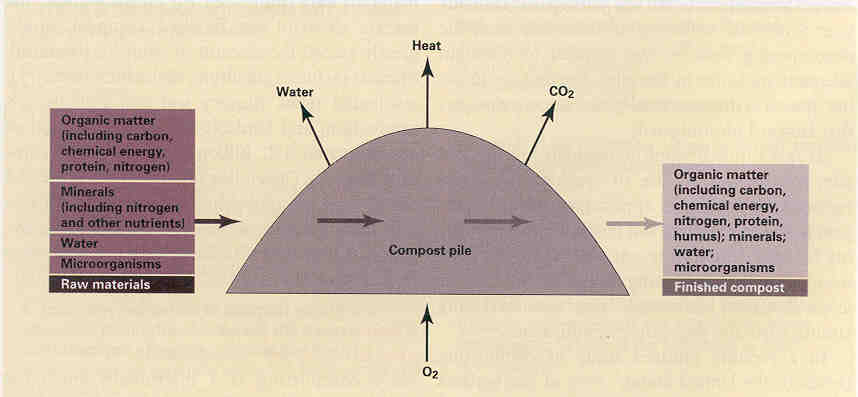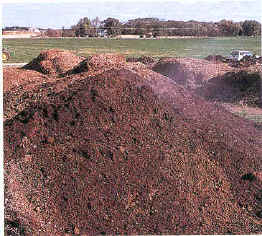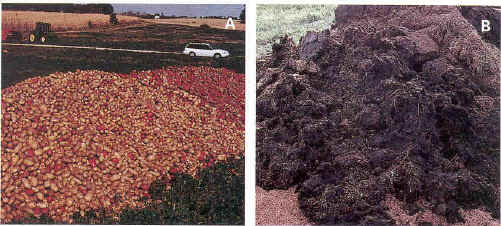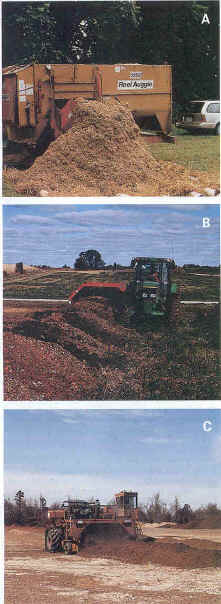Officers
Affiliates
Calendar
Membership
Programs
Awards
Gardens
Youth members
Hybridizing
Growing tips
Judges
Links
Back to main page
-
Composting: Art and Science
of Organic Waste Conversion
to a Valuable Soil ResourceSource: Cooperband L R. Composting: Art and Science of Organic Waste Conversion to a Valuable Soil Resource. Laboratory Medicine. 2000;31:283-290. Material has been Reprinted with Permission from the American Society of Clinical Pathologists and Dr. LR Cooperband. Abstract Composting is the manipulation of a biological
process, decomposition; raw organic materials such as manure, leaves, grass clippings, food wastes, and municipal biosolids are converted to stable soil-like humic substances. Composting is an ancient technology undertaken on a variety of levels, from home to industrial. As landfills reach their capacity and ban acceptance of organic wastes, composting is an increasingly viable means of organic waste treatment. Moreover, the final product, finished compost, is a valuable soil resource with a variety of agricultural, horticultural, and silvicultural uses.
From the Department of Soil Science, University of Wisconsin, Madison. Reprint requests to Dr. Cooperband, University of Wisconsin, Department of Soil Science, 1525 Observatory Dr, Madison, WI 53706-1299. Composting is the transformations of raw organic materials into biologically stable, humic substances suitable for a variety of soils and plant uses. Essentially, composting is controlled decomposition, the natural breakdown process that occurs when organic residue comes in contact with soil. Composting is an ancient technology. There are Roman and biblical references to composting and numerous accounts of farmer composting practices in subsequent millennia. (1) George Washington, the nation’s first president, was also the nation’s first recognized composter. (2,3) Washington was acutely aware of the degradative effects of farming on the soil resource, and he built a "dung repository" to make compost from animal manure so he could replenish the soil’s organic matter.
Sir Albert Howard was probably the first agricultural scientist to bring a scientific approach to composting, almost 75 years ago in India. (4) His Indore process involved stacking alternate layers of animal manure, sewage sludge, garbage, straw, and leaves. Stacked material was turned occasionally over 6 months or longer, and leachate from the decomposing residues was recycled to maintain adequate moisture in the piles. Current composting practices use essentially the same principles that Howard promulgated.
As agriculture became increasingly mechanized after World War II, use of synthetic fertilizers replaced the practice of applying manure or compost to soil to maintain soil fertility, and composting fell into disuse. In recent years there has been resurgence in composting initiatives at various levels as urban and rural areas face increasing landfill costs and decreasing landfill space.
In a recently released study of composting trends in the United States, (5) 85% of the nation’s municipal waste stream was identified as organic. (6) This translates to approximately 177 million tons of organic waste per year, mostly as food scraps, yard trimmings, and paper. It does not include organic waste generated from agricultural and industrial sectors, including food processing, paper production, biotechnology, forest products processing, and livestock production. If all of these materials were composted, the estimated potential market demand for finished compost would greatly exceed the amount of compost produced. Markets include agriculture, silviculture (forestry), residential retail, nursery sod and ornamentals production, and landscaping, with a demand of approximately 1.27 billion tons of finished compost annually. Depending on the type of waste and the method of composting, average national savings from composting of municipal organic byproducts over conventional landfill disposal range from $9 to $38 per ton.
Chemistry, Physics, and Biology of Composting
Since composting is a microbially mediated process, providing the proper environmental conditions for microbes to decompose raw organic materials is crucial for success (Fig 1). The three most important factors for making good compost are the chemical makeup of the raw ingredients or feedstocks (quality and quantity of carbon and minerals, pH), the physical size and shape of the feedstocks and the porosity of the pile, and the population of organisms involved in the composting process (macrofauna and mesofauna; micororganisms including bacteria, actinomycetes, fungi). Compost "happens" either aerobically or anaerobically when organic materials are mixed and piled together. Aerobic composting is the most efficient form of decomposition and produces finished compost in the shortest time.

Fig 1. Schematic of composting process. Carbon, chemical energy, protein, and water in finished compost are less than that in the raw materials; the finished product has more humus. The volume of the finished compost is approximately 50% less than that of the raw materials. Source: Rynk R. On-Farm Composting Handbook, NRAES-54, Ithaca, NY: Natural Resource, Agriculture, and Engineering Service, Cooperative Extension; 1992:1-186. Used with permission.
Microbes break down organic compounds to obtain energy to carry on life processes. Under aerobic conditions, the "heat" generated in composting is a by-product of biologic "burning," or aerobic oxidation of organic matter to carbon dioxide. If the proper amounts of food (carbon), water, and air are provided, aerobic organisms will dominate the compost pile and decompose the raw organic materials most efficiently. Optimal conditions for rapid, aerobic composting include carbon-nitrogen (C:N) ratio of combined feedstocks between 25:1 and 35:1, moisture content between 45% and 60% by weight, available oxygen concentration greater than 5%, feedstock particle size no greater than 1 inch, bulk density less than 1,000 pounds per cubic yard, and pH between 5.5 and 8.5.
Microbial "Food" Quality
The supply of carbon relative to nitrogen (C:N ratio) determines whether net mineralization or immobilization of nitrogen will occur. Mineralization is conversion of organic nitrogen to mineral forms (i.e., ammonium and nitrate); immobilization is incorporation of nitrogen into microbial biomass. As a general rule, if the C:N ratio is greater than 20:1, microbes will immobilize nitrogen into their biomass. If C:N is less than 20:1, nitrogen can be lost to the atmosphere as ammonia gas, causing odor. In general, green materials have lower C:N ratios than woody materials or dead leaves do, and animal wastes are more nitrogen rich than plant wastes are. The complexity of the carbon compounds also affects the rate at which organic wastes are broken down. The ease with which compounds degrade generally follows the order carbohydrates > hemicellulos > cellulose = chitin > lignin. Fruit and vegetable wastes are easily degraded because they contain mostly sugars and starches. In contrast, leaves, stems, nutshells, bark, and tree limbs and branches decompose more slowly because they contain cellulose, hemicellulose, and lignin.
Water Requirements
Low moisture content impedes the composting process, because microbes need water. Low moisture also makes compost piles more susceptible to spontaneous combustion, because moisture content regulates temperature. Moisture content in excess of 60% means pore spaces in the compost pile are filled with water rather than air (oxygen), leading to anaerobic conditions. Feedstocks with different moisture-holding capacities can be blended to achieve ideal moisture content. Carbonaceous materials such as newspaper and wood by-products such as sawdust are often used as bulking (drying) agents.
Other Environmental Considerations
A minimum oxygen content of 5% should be maintained for aerobic composting. As microbial activity increases in the compost pile, more oxygen is consumed. If the oxygen supply is not replenished, composting can shift to anaerobic decomposition, which often results in foul odor. Bacterial decomposers prefer pH in the range of 6.0 to 7.5, and fungal decomposers prefer pH of 5.5 to 8.0. Certain materials, such as paper processing wastes and cement kiln dust, can increase pH, and raw animal wastes and processed food wastes can lower pH. If compost pH exceeds 7.5, gaseous loss of ammonia is more likely. The particle size of organic wastes for composting is important for microbial activity and airflow in the compost pile. Smaller particles have more surface area per unit volume; therefore, microbes have greater access to their substrate. Thus, grinding of feedstocks before composting can accelerate the composting process. However, if particles are too small, airflow (and oxygen availability) within the compost pile will be restricted, resulting in anaerobic conditions.
Ambient air temperature can affect microbes in the compost pile and hence the rate at which the raw materials decompose. In temperate climates, composting is fastest in spring to fall; microbial activity can come to a standstill in winter. The size and configuration of the compost pile affect oxygen content and temperature. For a pile to heat up and stay hot, the minimum volume should be 1 cubic yard. Small piles are able to maintain higher internal oxygen concentrations than large piles can, but large piles retain higher temperature better than small piles do. The ideal pile height for aerobic composting is no greater than 5 to 6 feet.
The Composting Process
Mesofauna such as mites, sowbugs, worms, springtails, ants, nematodes, and beetles do most of the initial mechanical breakdown of organic materials into smaller particles. Mesophilic bacteria, fungi, actinomycetes, and protozoa (microbes that function at temperature between 10°C and 45°C (50°F - 113°F) initiate the composting process, and as temperature increases as a result of oxidation of carbon compounds, thermophiles (microorganisms that function at temperature between 45°C and 70°C [113°F - 157°F] ) take over. Temperature in a compost pile typically follows a pattern of rapid increase to 49°C to 60°C (120°F - 140°F) within 24 to 72 hours of pile formation and is maintained for several weeks (Fig 2). This is the active phase of composting, in which easily degradable compounds and oxygen are consumed, pathogens (e.g., Escherichia coli, Staphlococcus aureaus, Bacillus subtilus, Clostridium botulinum) and weed seeds are killed, and phytotoxins (organic compounds toxic to plants) are eliminated. During the thermophilic, active composting phase, oxygen must be replenished by mixing, forced aeration, or turning of the compost pile.

Fig 2. Steaming compost pile during active, thermophilic phase of composting, when compost temperature can reach as high as 66°C (150°F). As the active composting phase subsides, temperature gradually declines to around 38°C (100°F). Mesophilic organisms recolonize the pile, and the "curing" phase begins. The rate of oxygen consumption declines to where compost can be stockpiled without turning. During curing, organic materilas continue to decompose and are converted to biologically stable humic substances (mature or finished compost). Curing is a critical and often neglected stage of composting. (1) A long curing phase is needed if the compost pile has been managed poorly (too little oxygen, too little or too much moisture) and the compost is unfinished or immature. Immature compost can contain high levels of organic acids and have a high C:N ratio, extreme pH value, or high salt content, all of which can damage or kill plants when the compost is amended to pots or soil. There is no clearly defined duration for curing; common practice in commercial composting operations is to cure for 1 to 4 months, and homeowner compost piles can cure for as long as 6 to 9 months. Compost is considered finished or stable after temperature in the pile core reaches near-ambient levels and oxygen concentration in the middle of the pile remains greater than 5% for several days. These measurements should be made when the compost pile has at least 50% moisture content and a minimum critical volume of 1 cubic yard to retain heat. Dinel et al (7) loosely define compost maturity as the state when compost is dominated by bioresistant organic compounds or humic substances.
Qualities of Finished CompostJust as beauty is in the eye of the beholder, the end use market defines compost quality to a large extent. Numerous chemical, physical, and biologic parameters are used to evaluate compost quality. Aside from temperature requirement to kill pathogens (55°C [130°F] for at least 72 hours) and general acceptance of US Environmental Protection Agency biosolids rules (EPA 503) for trace metal concentrations, there are no federal standards for finished compost. In general, characteristics such as color, odor, pH, salt content, particle size, presence of undesirable materials (e.g., glass, plastics), heavy metal content, and biologic activity are used to define compost quality for specific end uses (Table 1). It is also important to characterize total and plant-available carbon and nutrients (e.g., nitrogen, phosphorus, potassium, calcium, magnesium, micronutrients) if the compost will be used for crop production.
Table 1. Compost Quality Guidelines Based on End Use
________________End Use of Compost_________________
Characteristic Potting Grade Potting Media
Amendment Grade*Top Dressing
GradeSoil Amendment
Grade*Recommended Uses
Growing medium without additional blending Formulating growing media for potted plants (pH <7.2) Primarily turf top dressing Improvement of agricultural soils, restoration of disturbed soils, establishment and maintenance of landscape plants (pH <7.2) Color
Dark brown to
blackDark brown to
blackDark brown to
blackDark brown to
blackOdor
Good, earthy
smellNo objectionable
odorNo objectionable
odorNo objectionable
odorParticle size (in)
<1/2<1/2 <1/4 <1/2 pH
5.0-7.6Should be
identifiedShould be
identifiedShould be
identified
Soluble salt content (mmhos/cm)<2.5 <6.0 <5.0 <20.0 Foreign Materials
Not more than 1%
by dry weight of
combined glass,
plastic, other
foreign particles
1/8 - 1/2 inNot more than 1%
by dry weight of
combined glass,
plastic, other
foreign particles
1/8 - 1/2 inNot more than 1%
by dry weight of
combined glass,
plastic, other
foreign particles
1/8 - 1/2 inNot more than 5%
by dry weight of
combined glass,
plastic, other
foreign particles
Heavy metals
Not to exceed EPA
standards for
unrestricted use
(US EPA 503
Regulations for
Biosolids)Not to exceed EPA
standards for
unrestricted use
(US EPA 503
Regulations for
Biosolids)Not to exceed EPA
standards for
unrestricted use
(US EPA 503
Regulations for
Biosolids)Not to exceed EPA
standards for
unrestricted use
(US EPA 503
Regulations for
Biosolids)
Respiration rate (mg/kg per hour)#<200 <200 <200 <400 EPA
EPA, Environmental Protection Agency*For crops requiring pH greater than or equal to 6.5, use line-fortified product. Lime-fortified soil amendment grade should have a soluble salt concentration less than 30 mmhos/cm.
#Respiration rate is measured by the rate of oxygen consumption and is an indication of biologic stability.
Source: Rynk R. On-Farm Composting Handbook, NRAES-54, Ithaca, NY: Natural Resource, Agriculture, and Engineering Service, Cooperative Extension; 1992:1-186. Used with permission.
Potential end uses of compost include potting mixes for container crops grown in greenhouses and nurseries, soil amendments for field nursery and sod production, turf and highway greens establishment, landscaping, homeowner gardens, agronomic (i.e., cash grains) and horticulture (e.g., fruits, vegetables) crop production, silviculture (e.g., forestry, paper raw materials), remediation of contaminated sites (e.g., brown fields, mine spoils), and landfill cover. In all cases, compost can replace materials such as peat, topsoil, and synthetic fertilizer. High-value markets (e.g, nurseries, landscaping, turf, horticulture crops) require high-quality compost, whereas low-value markets (e.g., grain crops, site remediation, landfill cover) cannot justify the cost of high-quality compost production. The lower value markets can tolerate immature compost if applied several months prior to planting. Potential markets range in size from 0.6 million cubic yards for landfill cover and surface mine reclamation to close to 900 million cubic yards for agricultural and horticultural applications (Table 2). Benefits of compost addition to soil have been noted extensively in recent literature and include increased soil organic matter content, increased water retention in sandy soil, increased cation exchange capacity, restoration of soil structure (i.e., aggregate stability), reduction of fertilizer requirement by at least 50% (8), disease suppression of certain pathogens (9), reduction of heavy metal bioavailability, and bioremediation of xenobiotic-contaminted soils. (10, 11)
Table 2. Applications for Compost and Potential Market Size
Application Size
(million cubic yards/year)Agriculture
895 Silviculture
104 Sod Production
20 Residential retail
8 Delivered Topsoil
3.7 Landscaping
2 Nurseries
0.9 Landfill cover, surface mine reclamation
0.6 Source: US Environmental Protection Agency. Organic Materials
Management Strategies. EPA 530-R-97-003. Washington, DC; 1998:1-53.
Home Composting
Garden and Kitchen Waste
Landfill banning of municipal organic wastes such as leaves and grass clippings in the late 1980s, along with increased homeowner interest in recycling and organic gardening, has been a boon for home composting. Home composting is one of the most cost-effective organic materials management strategies because it eliminates the costs of collection and processing. (12) There are approximately 1,000 home composting programs in use in the United States, and the number is growing by leaps and bounds. (13) Municipal home composting programs include bin subsidization and distribution, composting workshops, master composter programs (analogous to master gardener), and educational brochures.
Homeowners are composting garden and food wastes along with leaves and grass clippings. Numerous composting bins are available for use inside the home (e.g., worm bins or vermicomposters, food scrap composting bins) and in the backyard. Although these bins can differ in construction material (e.g., plastic, wood), configuration, and size, all enable the homeowner to compost organic waste using chemical and biological principles.
Organic waste suitable for home composting includes grass clippings, hay, straw, sawdust, wood chips, kitchen waste (e.g., fruit and vegetable peels and rinds, tea bags, coffee grounds, eggshells), leaves, and animal manure (e.g., chicken, cow, horse). It is best to combine dry, high-carbon materials (e.g., woody materials, straw, hay) with wet, high-nitrogen materials (e.g., grass clippings, food scraps, manure) to optimize the C:N ratio, moisture content, particle size, and pile porosity. By following the general guidelines for good aerobic composting, homeowners can minimize foul odor production and vector attraction. Homeowners should not compost meat scraps, fatty food waste, milk products, and bones, because these attract pests to the compost pile or bin. Weed plants can be composted if they have not gone to seed. It is best not to compost treated-wood waste, pet waste, and diseased plants, because their toxic substances and pathogens may not be destroyed in the composting process. Under most home composting conditions, it is difficult to achieve the high temperatures required to kill pathogens and weed seeds. As home composting has become more prevalent, numerous sources of information have become available.
Large-Scale Composting of Industrial and Agricultural Wastes
Fig 3. Common feedstocks in large-scale commercial composting include food processing wastes such as (A) cull potato and (B) dairy cow waste and straw bedding mixed with sawdust. 
Commercially available compost is derived from a variety of organic by-products, including animal manure, food processing waste, biosolids (sewage sludge), yard debris, and wood processing byproducts (Fig 3). These materials are generated in large volume and are composted by either the waste generator or a commercial composter. In either case, states regulate large-scale composting; most facilities must obtain composting permits to ensure minimal negative environmental impact. As with home composting, commercial composting must respect the same set of biophysical conditions for proper aerobic composting. Because large volumes of organic wastes are involved, management of compost piles is intensive. In most cases, raw materials are either piled in long windrows outside or placed in long beds in climate-controlled buildings. Compost piles must be aerated either passively or actively (Fig 4). The most prevalent composting techniques used by large-scale composters are forced-air static piles, passively aerated static piles, and turned windrows (using either tractor-pulled or self-propelled windrow turning machines.) Some large-scale composting operations use completely enclosed in-vessel equipment to achieve maximum control of temperature, oxygen, and moisture.

Fig 4. Techniques for large-scale composting include (A) mixing poultry litter and agriculture by-products in a feed mixer for passive aeration composting, (B) using a tractor-pulled windrow turner to mix cannery wastes with sawdust and municipal leaves, and (C) turning poultry litter using a self-propelled windrow turner. Conclusion
Composting of organic wastes is an environmentally sound means of diverting organic waste from landfills and producing valuable soil amendments. Composting is a microbially mediated process that requires a specific set of chemical and physical conditions. Compost can be produced on a variety of levels ranging from home composting to large commercial operations. Compost can be used in agriculture, horticulture, and silviculture production, as well as landscaping, home gardens, and remediation of contaminated sites. States and municipalities could adopt goals for reducing or eliminating organic waste landfilling so that composting becomes more widespread and more economically viable. In addition, the United States could develop federal guidelines for compost quality standards to maximize beneficial use of finished compost.

References
1. Rynk R. On-Farm Composting Handbook, NRAES-54. Ithaca, NY: Natural Resource, Agriculture, and Engineering Service, Cooperative Extension; 1992:1-186.
2. Arner R. George Washington: the composter of our country. Washington Post. Sunday "Free for All," September 10, 1995:A-20.
3. Pogue DJ, Arner R. George Washington, the revolutionary farmer: American’s first composter. City Farmer Web site, Canada’s Office of Urban Agriculture, February 13, 1997;1-3. Available at: www.cityfarmer.org (accessed May 1999).
4. Howard A. An Agricultural Testament. London, England: Oxford University Press: 1943:39-52.
5. US Environmental Protection Agency. Organic Materials Management Strategies. EPA530-R-97-003. Washington, DC: US Government Printing Office; 1998:1-53.
6. Sparks K. Organics take a number. Resource Recylcing. 1998;17:32-35.
7. Dinel H, Schnitzer M, Dumonet S. Compost maturity: chemical characteristics of extractable lipds. Comp Sci Util. 1996;4:16-25.
8. Werner W, Scherer H, Olfs HW. Influence of long-term application of sewage sludge and compost from garbage with sewage sludge on soil fertility criteria. Z Acker Planzenblau. 1988;160:173-180.
9. Hoitink HAJ, Stone AG, Han DY. Suppression of plant diseases by composts. Hortscience. 1997;32:184-187.
10. Barker AV. Composition and uses of compost. In Rechcigl JE, McKinnon HC, eds. Agricultural Uses of By-Products and Wastes. ACS Symposium Series 668. Washington, DC:1997;140-162.
11. Cole MA, Zhang L, Lui X. Remediation of pesticide contaminated soil by planting and compost addition. Comp Sci Util. 1995;38:20-30.
12. McGovern A. Home composting makes major impact. Biocycle. 1997;38:30-35.
13. Snow D. A commoner’s guide to backyard composting. MSW Management. 1999;16-25.
Suggested Reading
Appelhof M. Worms Eat My Garbage: How to Set Up & Maintain a Worm Composting System. Revised. Kalamazoo, MI:Flowerfield Press; 1997.
Appelhof M, Fenton MF, Harris BL, et al. Worms Eat Our Garbage: Classroom Activities for a Better Environment. Kalamazoo, MI:Flowerfield Press; 1993.
Campbell S. Let it Rot: The Gardener’s Guide to Composting. 3rd ed. Rownal, VT: Storey Books; 1998.
Roulac J. Backyard Composting: Your Complete Guide to Recycling Yard Clippings. 9th ed. White River Junction, VT: Chelsea Green Publishing; 1997.
Natural Resource, Agriculture, and Engineering Service, Cooperative Extension. Composting to Reduce the Waste Stream: A Guide to Small Scale Food and Yard Waste Composting, NRAES-43, Itaca, NY: Natural Resource, Agriculture, and Engineering Service, Cooperative Extension; 1991.